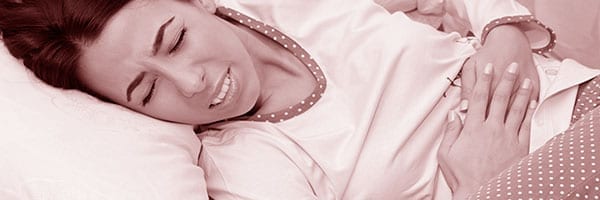
Many women with endometriosis who suffer from pelvic pain will also have co-existing urogynecological disorders that contribute to their symptoms. Sometimes one disorder may mask other co-occurring disorders and it takes a skilled physician to correctly differentiate the many possible sources of pelvic pain.
While endometriosis is a leading cause of pelvic pain, pelvic pain is often multifactorial in origin – it can stem from multiple causes.
The following conditions commonly co-occur with endometriosis and represent additional causes of pelvic pain:
Adhesions
Adhesions are bands of fibrotic tissue (scar tissue) that form between adjacent organs and structures, such as between the ovaries and pelvic sidewall and between the uterus and bowel. Adhesions can be thin, cobweb-like or dense and thick like hardened glue. They arise from pelvic disease, infection or injury. Over time the inflammation associated with endometriosis can cause the formation of scarring and adhesions and the surgery to remove the disease may result in further adhesions as the body heals. Some patients are more prone to forming adhesions than others. In severe cases it is almost as if a tube of superglue has been deposited into the pelvic cavity, causing structures to fuse and distorting the pelvic anatomy. If adhesions stretch or constrict a vital structure such as the bowel this can result in pain and other symptoms, such as bowel obstruction and nausea. Surgery can be performed to remove painful adhesions. A problem, however, is in preventing the adhesions from reforming during the healing process. The use of adhesion barriers and an early second look procedure to take down newly forming adhesions before they become established can help provide ongoing relief.
Adenomyosis
Adenomyosis is a close relative of endometriosis, and is when endometriotic tissue is found within the muscular walls of the uterus. The two main symptoms of adenomyosis are severe uterine cramping that worsens with the menstrual flow and unusually heavy periods. Not all women with adenomyosis have symptoms.
Interstitial cystitis (painful bladder syndrome)
Interstitial cystitis (IC) is a chronic bladder condition that often mimics a bladder infection. The most common symptoms are pelvic pain, pelvic pressure, pain with urination, urinary frequency and urinary urgency. Women with IC typically have smaller bladder capacity and when the inside of the bladder is inspected via cystoscopy glomerulations (small capillary bleeding from the bladder wall) and Hunner’s ulcers (lesions or sores on the lining of the bladder) may be observed. Unlike endometriosis, IC cannot be surgically removed but there are treatments that can help manage symptoms, including dietary changes, bladder instillations and medications.
Pelvic floor muscle spasm
Chronic pelvic pain can result in a tightening of the pelvic floor muscles. When the pelvic floor muscles become overly tight or overly relaxed or loose (such as following childbirth) the patient is said to have Pelvic Floor Dysfunction (PFD). Some patients with endometriosis or other forms of chronic pelvic pain will go on to develop pelvic floor muscle spasms due to a tightening of the pelvic floor muscles in response to ongoing severe pelvic pain. Pelvic floor muscle spasms are excruciatingly painful and can occur spontaneously or become triggered by activity, such as sexual intercourse. Pelvic physical therapy can help alleviate the painful and debilitating symptoms of PFD and pelvic floor muscle spasm.
Fibroids
Fibroid tumors are accumulations of smooth muscle tissue that form within the muscular walls of the uterus. A woman may develop multiple fibroids and the tumors can vary in size from smaller than a marble to larger than a grapefruit. Fibroids if symptomatic can cause heavy periods and uterine cramping that worsens with menstruation.
Uterine retroversion
Normally the uterus is anteverted; it is tilted forward slightly, toward the bladder. In approximately 1 in 5 women the uterus is retroverted; it is tilted backward toward the bowel. While retroversion of the uterus is considered a normal phenomenon it can be associated with lower back pain, painful sex and painful bowel movements. Retroversion may be more symptomatic in women who have co-occurring uterine pathology, such as fibroids and adenomyosis.
Uterine prolapse
Uterine prolapse is when the uterus drops down into and sometimes out of the vagina. It is more common in patients who have had previous vaginal deliveries, as the process of childbirth can loosen the pelvic support structures that support the uterus. Prolapse is also more common in women post-menopause as the drop in estrogen levels can also reduce the tone of the support structures in the pelvis. Patients suffering from prolapse may complain of a bearing down sensation and lower back pain. Prolapse may also be associated with stress incontinence (where lifting, coughing, sneezing and/or exercise result in loss of urine).
Pelvic congestion
Pelvic congestion, uterine varicosities and ovarian vein varicosities (varicose veins) are all variations of enlarged pelvic blood vessels and may present as a source of pelvic pain. Pelvic congestion may be manageable conservatively or via radical organ removal (hysterectomy) depending on the site of the varicosities.
Ovarian cysts
The most common non-endometriotic ovarian cysts are functional cysts (follicular cysts and corpus luteal cysts). Functional cysts form and resolve as a normal part of the menstrual cycle. Sometimes functional cysts may persist longer than normal and cause pain. Even the presence of one or more small to medium-sized cysts can stretch the ovary causing pain. If the ovary is also involved by scar tissue or adhesions, the presence of a functional cyst during the cycle can cause a cyclical stretching of the scar tissue producing a painful pulling sensation. If a cyst ruptures, this may result in acute pain. Not all cysts are symptomatic. Sometimes a patient will have large ovarian cysts without any symptoms at all. Non-functional cysts include endometriomas, hemorrhagic corpus lutea and dermoid cysts. Imaging can help differentiate between functional and non-functional cysts. Endometriomas and dermoid cysts do not resolve on their own without surgery.
Ovarian torsion
Ovarian torsion is when an ovary twists on itself. Torsion is associated with acute lower abdominal pain and represents a medical emergency. If the torsion is not resolved quickly the blood supply to the ovary may be compromised and the ovary may cease to function, resulting in loss of the ovary.
Abdominal wall neuropathy
The ilio-inguinal, ilio-hypogastric, and genital femoral nerves are found in the lower abdominal wall between the belly button and hipbone, down to the groin and upper leg. When these nerves are damaged, a nerve block or trigger-point injection can be helpful; often, a series of nerve blocks can ease the pain. In some cases, a technique called radiofrequency nerve ablation is used to provide longer lasting relief.
Pudendal neuropathy and pudendal nerve entrapment (PNE)
The pudendal nerve is located along the side of the vagina. This nerve has three basic branches: an anterior branch, to the clitoris; a middle branch, to the vaginal and vulvar area; and a posterior branch, to the anus. Pain can be present in any portion of the nerve if it becomes damaged or entrapped. The pain is often worse when the patient is sitting. Pudendal neuropathy can be treated with pudendal nerve blocks and pelvic physical therapy. In some cases radiofrequency ablation of the pudendal nerve may be helpful.
Ovarian remnant syndrome
An ovarian remnant is when a small piece of ovarian tissue is left behind following removal of an ovary. This can occur if the ovary is fused by adhesions to the adjacent pelvic sidewall prior to removal. In such cases, the ovary must first be carefully peeled away from the adherent structures without leaving a remnant behind. Ovarian remnant syndrome is when a patient experiences pain as a result of the ovarian remnant. Sometimes a remnant will be identified by the presence of a cyst in the ovarian tissue on ultrasound or by persistently elevated estrogen levels (in the case of removal of both ovaries). Ovarian remnant syndrome can be resolved by surgically removing the remaining remnant of ovarian tissue.
Foreign body
Pelvic pain may result from foreign materials left in the body after a previous procedure, such as surgical staples and mesh. Sometimes a foreign body may result in a chronic inflammatory reaction called a foreign body giant cell reaction. Foreign body reactions can be resolved by removing the source of the reaction. Avoiding the use of foreign non-biodegradable materials in the body can prevent these reactions from occurring in the first place.
Hernia
Groin hernias include inguinal, obturator and femoral hernias. Inguinal hernias are the most common. Inguinal hernias are actually an uncommon source of pelvic pain and are often over-diagnosed and treated with mesh, which can then become a new source of pelvic pain. For this reason, inguinal hernias should be treated without mesh. Sometimes a patient may develop a painful abdominal wall hernia, including umbilical hernias, incisional hernia and ventral hernias. Surgical correction can resolve the hernia and any associated pain.
Appendicitis
Appendicitis is a condition in which the appendix becomes inflamed. In the case of acute appendicitis, the onset of inflammation is sudden and is accompanied by severe right-sided pelvic pain that brings the patient to the ER and the appendix is removed during emergency surgery. Occasionally a patient will present with chronic appendicitis or her acute pain will be passed off as endometriosis pain, potentially leading to a life-threatening situation if the appendix then ruptures.
Food sensitivities and food allergies
While technically different, food allergies and food sensitivities can result in similar types of problems. A food allergy, such as to seafood, is mediated by the immune system: the patient may break out in a rash and/or may experience difficulty breathing. A food sensitivity, such as lactose intolerance, has an end-organ response: the patient reacts to the food with, for example, a spasm of the bowel.
Gluten is a protein found in wheat, rye, barley, oat bran, and wheat germ. While it can cause celiac disease, gluten is also a leading cause of food sensitivity. The symptoms are very similar. With celiac disease, the lining of the gastrointestinal tract becomes damaged, but the pain with gluten sensitivity – such as severe bowel pain, up to a level of 10/10 – can be just as severe. Other symptoms include bloating, diarrhea, skin problems, headaches, even neurologic symptoms, such as irritation and anxiety. Food sensitivities can also contribute to or cause pain in the vulvar area and make interstitial cystitis symptoms worse.
Gastrointestinal problems
Bowel problems are common in pelvic pain patients. Many patients report bloating, cramping, gassiness, and alternating bouts of constipation and diarrhea. One cause of gastrointestinal problems includes food allergies and sensitivities. Other causes of gastric symptoms include bowel motility problems or spastic bowel, bowel obstructions due to adhesions, redundant colon (an extra length of colon), diverticulitis (when a small pouch forms in the colon and becomes infected) and anal fissures, a crack in the lining of the anus, often resulting from constipation.
Generalized visceral hypersensitivity
Visceral refers to the internal organs and hypersensitivity refers to abnormally increased sensitivity. With generalized visceral hypersensitivity, the entire inside of the body hurts. This is usually because inappropriate signals are being sent by the nervous system, creating types of neuropathic pain or centralized pain.
Vulvodynia
The vulva is the area surrounding the outside of the vagina. Vulvodynia means “pain of the vulva.” There are two general types of vulvodynia. Patients with generalized vulvodynia can experience pain anywhere on the vulva between the thighs. It can involve the entire area or specific, isolated areas. The pain can be intermittent or constant. Vulvar vestibulitis involves pain of the vestibule, the small area around the opening of the vagina inside the labia minora, or inner lips. Pain is only present with pressure on the area, such as with intercourse or tampon insertion.





